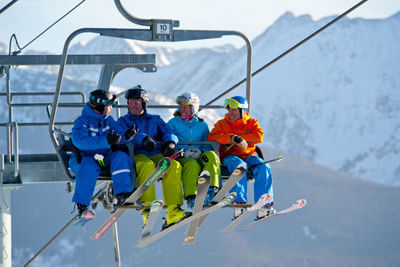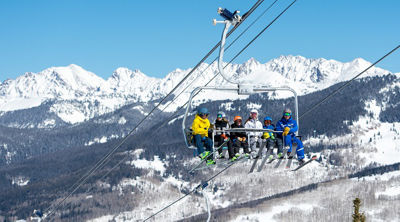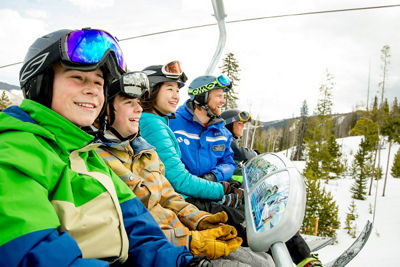Lift Safety

Getting On
Prep:
- If you’re new to riding chairlifts, watch how others around you load the chair—then mirror what works for them!
- Remove your pole straps from your wrists, gathering them in one hand. Secure any loose items like scarves and mittens, and remove backpacks. Put your cell phone back in your pocket!
- Line up with other passengers along the “Wait Here” board embedded into the snow.
- Communicate with the lift operator. If you are nervous, tell them. If you think you need assistance, tell them. If you just don't know exactly what to do, ask.
- After a chair passes, follow it and make your way to the “Load Here” board.
Look:
- Look over your shoulder as the chair approaches.
Sit:
- Sit down when the chair touches the back of your legs, grasping the chair as needed.
- Lower the bar—first double checking that your chairmates are ready.
Relax:
- Sit all the way back in the chair, scooting towards the backrest.
Riding the Chairlift
Pay Attention
- Stay in tune with your surroundings to make for a more enjoyable ride.
- Don’t use this time to adjust clothing or equipment, instead sit back and relax.
Look for Signs. Read Them.
- Our signage has lots of tips, information about the terrain the lift serves, and warnings about the skill level for the terrain served by the lift.
Keep Calm and Ride On
- Do not lean forward while riding the lift. If the lift stops, don’t worry, it happens! Instead, enjoy the extra time to plan out your next run.
- Lower and use the chair bar, but ask your chairmates before you do so.
Unloading
Tips Up: Keep the tips (or nose) of your skis/snowboard up as you approach the unloading zone.
Bar Up: When your chair arrives at the “Raise Here” sign in the upper terminal, raise the chairlift bar.
Stand Up: Stand up when your sliding device (or your feet) hit the snow (or the unload deck, if it’s summer).
Keep Up (the Pace):
- Do not try to slow down or stop as you push away from the chair.
- Keep your skis/snowboard pointed downhill to help you glide away from the chair. If you ride a snowboard, keep your back foot on the board (but don't try to skate away from the chair).
- Clear the unloading zone quickly. Do not strap into your snowboard in the unloading zone.
How To: Kids on Lifts , opens in a new window
Chairlifts and children: fortunately, there is only one first time. Even though teaching your children to get on the chairlift can be a little tricky, just a little coaxing and coaching goes a long way.
If this is your first time loading a lift, make sure you ask the lift operator to slow down the chair—and don’t forget to review our pointers below!
Loading
- Before using a chairlift, start your kids at the magic carpet so they can get familiar with the sensation of being carried.
- Organize the little ones: talk through and watch the steps of getting onto the lift with your child before you get in line.
- Ask a uniformed employee if there is a practice chair so your child can understand how the chair works.
- Take them to a beginner area chair lift and show them how other kids load the chair properly.
- Talk to the lift operator: let them know before you load that you might need help.
- Make sure younger kids know how to use their hands to push their rear ends to the back of the chair. They might need to grab the chair or the bar. Be prepared to give them a boost!
- Line children up so they are closest to the lift operator when loading.
- If you are the parent or adult riding with children, position yourself directly next to the child or in the middle position if you are riding with more than one child.
- Remember that all riders on a chairlift must be able to load and unload using their own power, so this means no infants or young ones in carriers.
On the Lift
- Where equipped, make sure the chairbar is down.
- Remind your children they could fall off the lift if they engage in horseplay or do not sit still.
- Do not attempt to adjust clothing or gear.
- If you (or your child) does drop something, let it fall! You can retrieve your lost item on your next lap if the terrain is open and in your ability level, and if you can’t find it or access the area, notify the lift operator about the missing item.
Unloading
- Help your children get to their feet, steering them downhill. If the child has a vest or handle, use it to assist them if needed.
- Clear the loading zone as quickly as possible.
Would you like to give your children a leg up on riding the lift? Try a lesson with one of our expert Ski & Ride School instructors!

Chairlift Guidelines
Obey All Signage
Signs may be instructive, informative, or warnings; read and obey the information shared on them.
Heed the Lift Operator
Lift Operators are familiar with their operations, so listen up when they have something to share.
No Horseplay
Skiing and snowboarding may be all fun and games, but lift safety is a serious issue.
Ride Safely
Per the Skier’s Responsibility Code, you cannot board a lift unless you have sufficient physical dexterity, ability and knowledge to negotiate or to use such lift safely or until you have asked for and received information sufficient to enable you to use the lift safely. For this reason, infants or small children in carriers are not permitted on chairlifts. Do not use a lift or any ski trail when under the influence of drugs or alcohol.
Accommodations
At Vail Resorts we pride ourselves on providing an Experience of a Lifetime to all of our guests. If you, a family member, or a traveling partner will require an ADA reasonable accommodation at any of our resorts, we kindly request that you notify us at least 72 hours in advance of your visit so that we may work with you to provide a safe and enjoyable experience. Here at Vail, you may reach out to our team at vail_accommodation@vailresorts.com to make your request.
Animals on Lifts
Pets are not allowed to use chairlifts for safety reasons.
A service animal can ride the chairlift as long as it is harnessed, leashed, or tethered to the handler (owner) at all times while on the lift. The service animal must be unable to move on its own to help prevent the animal from jumping or falling off of the lift, potentially onto a person below, or posing a safety risk to guests or employees using the lift. In addition, the handler must be unhindered by the service animal and able to negotiate and use the lift safely, including loading and unloading the chair properly.
Where possible, it is strongly recommended that individuals with service animals access the gondola, which generally provides safer access than a chair lift for the handler, service animal, other guests and employees.
Frequently Asked Questions (FAQs)
The avalanche rescue dogs that Ski Patrol uses are rigorously trained search-and-rescue dogs and avalanche dogs. Outside of their rescue training, they undergo specific instruction for chairlift riding, socialization, and obedience. “Chairlift socialization,” or the training that rescue dogs undergo to be able to ride chairlifts, even begins as early as 8 weeks old!
Moreover, they are certified after training by credentialing organizations. As such, our rescue dogs aren’t just highly qualified work partners—they’re also highly qualified to ride chairlifts!
First, a note: all the information we’ve shared on this page pertains to riding chairlifts in the winter, since they are the primary means of guest transportation to skiable/rideable terrain within resort boundaries.
That said, we’ve listed a few more distinctions below:
Transportation Type: Gondolas are closed cabin lifts that can transport between 4 and 15 people, while chairlifts provide open-air transportation seating for up to 6 people.
Terrain Served: Our gondolas primarily provide guest access to key base, mid-mountain, and summit areas, while chairlifts tend to serve skiable/rideable terrain in a wider range of areas within resort boundaries. Gondola-served terrain may include areas accessible to foot traffic.
Activities Supported: Chairlifts enable many winter activities (i.e. skiing and snowboarding) as well as summer fun (i.e. mountain biking and hiking). Gondolas also support winter and summer activities, while also enabling guests to sightsee around our mountain without additional gear or equipment. Certain strollers, wheelchairs, or other mobility devices may also be used on gondolas.
Loading and Unloading Skills: Both chairlifts and gondolas require passengers to heed posted signage and instructions from the lift operator. Chairlifts tend to require more loading and unloading knowledge and skill than gondolas, regardless of the season.
If you’d like to explore on-mountain areas accessible to foot traffic you’ll need to take a gondola to visit these zones.
Please consult your trail map to find more options you can visit via gondola.
Lift closure varies on a case-by-case basis. Generally, chairlifts may close temporarily due to safety precautions related to maintenance or weather (which may not always be visible or obvious). The decision to shut down a lift is determined by Ski Area Management, which may include the managers of Lift Operations and Lift Maintenance departments, as well as the Director of Mountain Operations.
In the morning, lift open times may be delayed if snow safety and lift safety operations are underway.
using their own individual ability and knowledge.
That means 3 things:
- Your may not ski or snowboard with your baby in a backpack.
- You may not load chairlifts with a baby in a backpack (even in the summer).
- If you want to carry your baby in a backpack, use the gondola.


